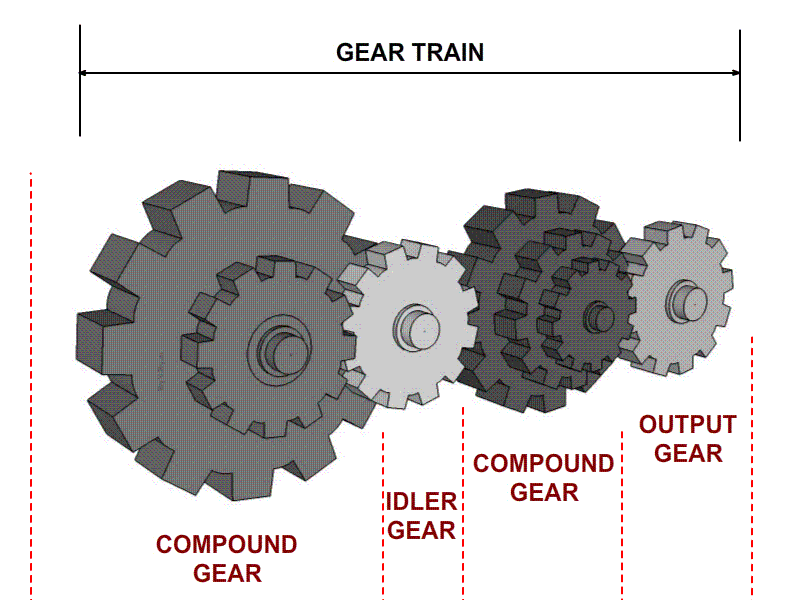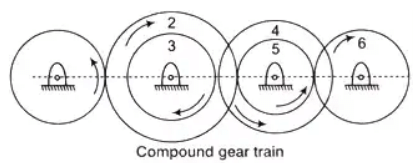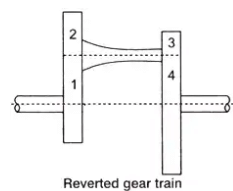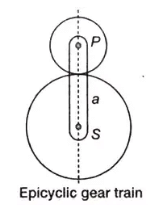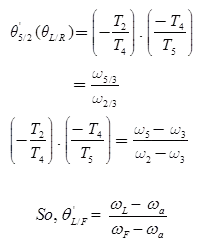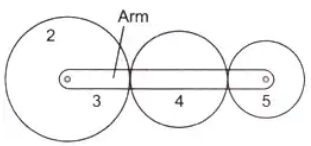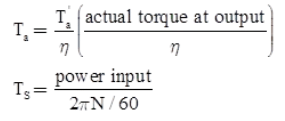Mechanical Engineering Exam > Mechanical Engineering Notes > Theory of Machines (TOM) > Study Notes for Gear Trains
Study Notes for Gear Trains | Theory of Machines (TOM) - Mechanical Engineering PDF Download
What is Gear Train?
- When two or more gears are made to mesh with each other to transmit power from one shaft to another, the combination is called gear trains.

- A gear train is a combination of gears used to transmit motion from one shaft to another. Gear trains are used to speed up or stepped down the speed of driven shaft.
Types of Gear Trains
- Simple Gear Train: Series of gears, capable of receiving and transmitting motion from one gear to another is called a simple gear train.
Train value
 Speed ratio = 1/Train value
Speed ratio = 1/Train value
The intermediate gears have no effect on the speed ratio and therefore they are known as idlers.Question for Study Notes for Gear TrainsTry yourself:In a simple gear train, if the number of idle gears is odd, then the motion of driven gear willView Solution - Compound Gear Train: When a series of gears are connected in such a way that two or more gears rotate about an axis with the same angular velocity.


- Reverted Gear Train: If the axis of the first and last wheel of a compound gear coincide, it is called as reverted gear train.
Train valve,
If r is the pitch circle radius of a gear
r1 + r2 = r3 + r4
- Planetary or Epicyclic Gear Train: A gear train having a relative motion of axes is called a planetary or an epicyclic gear train. In an epicyclic train, the axis of at least one of the gears also moves relative to the frame. If the arm a is fixed the wheels S and P constitute a simple train. However if the wheel S is fixed so that arm a can rotate about the axis of S. The P would be moved around S therefore it is an epicyclic train.

- In general, gear trains have 2 degree of freedom.


First order kinematic coefficient
- Torque in epicyclic Trains: Let NS, Na, Np, and NA be the speeds and TS, Ta, Tp, and TA the external transmitted by S, a, P and A
∑T = 0
TS + Ta + Tp + TA = 0
Since planet P can rotate on its our pin fixed to a but is not connected to anything outside.
Tp = 0
TS + Ta + TA = 0
Assuming no loss in power transistor
∑Tω = 0
TSNS + TaNa + TANA = 0
If efficiency η to deliver power to S.
- Tabular Method: In tabular method, we apply following procedure. Assume gear makes m revolution and arm makes n revolution.
Consider clockwise rotation is positive and anticlockwise rotation is negative.
Analysis of Tabular Method: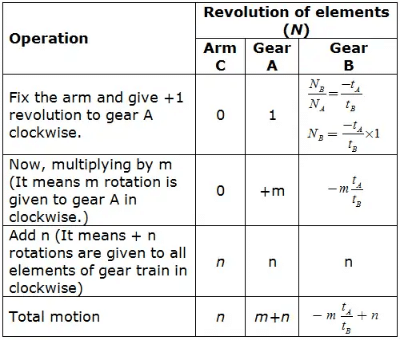 On the basis of given condition, we can determine the values m and n. For example, if gear A is at rust, then
On the basis of given condition, we can determine the values m and n. For example, if gear A is at rust, then
NA = 0
∴ m + n = 0 ....(i)
and arm is given +k revolution, then
n = k …(ii)
By solving Equations: (i) and (ii), we can find the values of m and n. Once we find out m and n then number of revolutions and direction of gear B can be determined as:
Question for Study Notes for Gear TrainsTry yourself:When the axes of first and last gear are co-axial, then gear train is known as
View Solution
The document Study Notes for Gear Trains | Theory of Machines (TOM) - Mechanical Engineering is a part of the Mechanical Engineering Course Theory of Machines (TOM).
All you need of Mechanical Engineering at this link: Mechanical Engineering
|
87 videos|43 docs|29 tests
|
FAQs on Study Notes for Gear Trains - Theory of Machines (TOM) - Mechanical Engineering
| 1. What is a gear train? |  |
Ans. A gear train is a mechanism consisting of multiple gears interconnected to transmit motion and power from one rotating shaft to another. It is commonly used in various mechanical systems to achieve different gear ratios and control the speed and torque of the output shaft.
| 2. What are the types of gear trains? |  |
Ans. There are several types of gear trains, including:
- Simple Gear Train: Consists of two meshing gears with parallel axes.
- Compound Gear Train: Contains more than two gears connected in series.
- Planetary Gear Train: Comprises a central gear (sun gear), surrounded by multiple gears (planet gears), and an outer ring gear (annulus).
- Epicyclic Gear Train: Another name for a planetary gear train.
- Reverted Gear Train: Consists of two identical gear trains connected in series.
| 3. What are the advantages of using gear trains? |  |
Ans. Gear trains offer several advantages in mechanical engineering applications, including:
- Speed Reduction/Increase: Gear trains can change the speed of the output shaft relative to the input shaft, allowing for speed reduction or increase as desired.
- Torque Amplification/Reduction: By altering the gear ratios, gear trains can amplify or reduce the torque being transmitted, enabling better power transmission efficiency.
- Direction Change: Gear trains can change the direction of rotation of the output shaft compared to the input shaft.
- Compact Design: Gear trains can be designed to transmit power efficiently in a compact space, making them suitable for various machines and devices.
- Adjustable Gear Ratios: Gear trains allow for easy adjustment of gear ratios, providing flexibility in controlling the output speed and torque.
| 4. How do gear trains work? |  |
Ans. Gear trains work based on the principle of meshing gears. When the input shaft rotates, its gear engages with the teeth of the next gear in the train, causing it to rotate. This process continues as each gear in the train meshes with the next gear until the final output shaft is reached. The gear ratio determines the relationship between the input and output shaft speeds and torques.
| 5. What are some common applications of gear trains? |  |
Ans. Gear trains are extensively used in various mechanical systems, including:
- Automotive Transmissions: Gear trains are used in vehicle transmissions to control the speed and torque delivered to the wheels.
- Industrial Machinery: Gear trains are employed in machinery such as conveyor systems, machine tools, and printing presses to drive different components and control their motion.
- Clocks and Watches: Mechanical clocks and watches utilize gear trains to accurately measure and display time.
- Robotics: Gear trains are utilized in robotic systems to transmit power and control the movement of robotic joints.
- Wind Turbines: Gear trains are used in wind turbines to convert the low-speed rotation of the blades into high-speed rotation for power generation.
Related Searches

